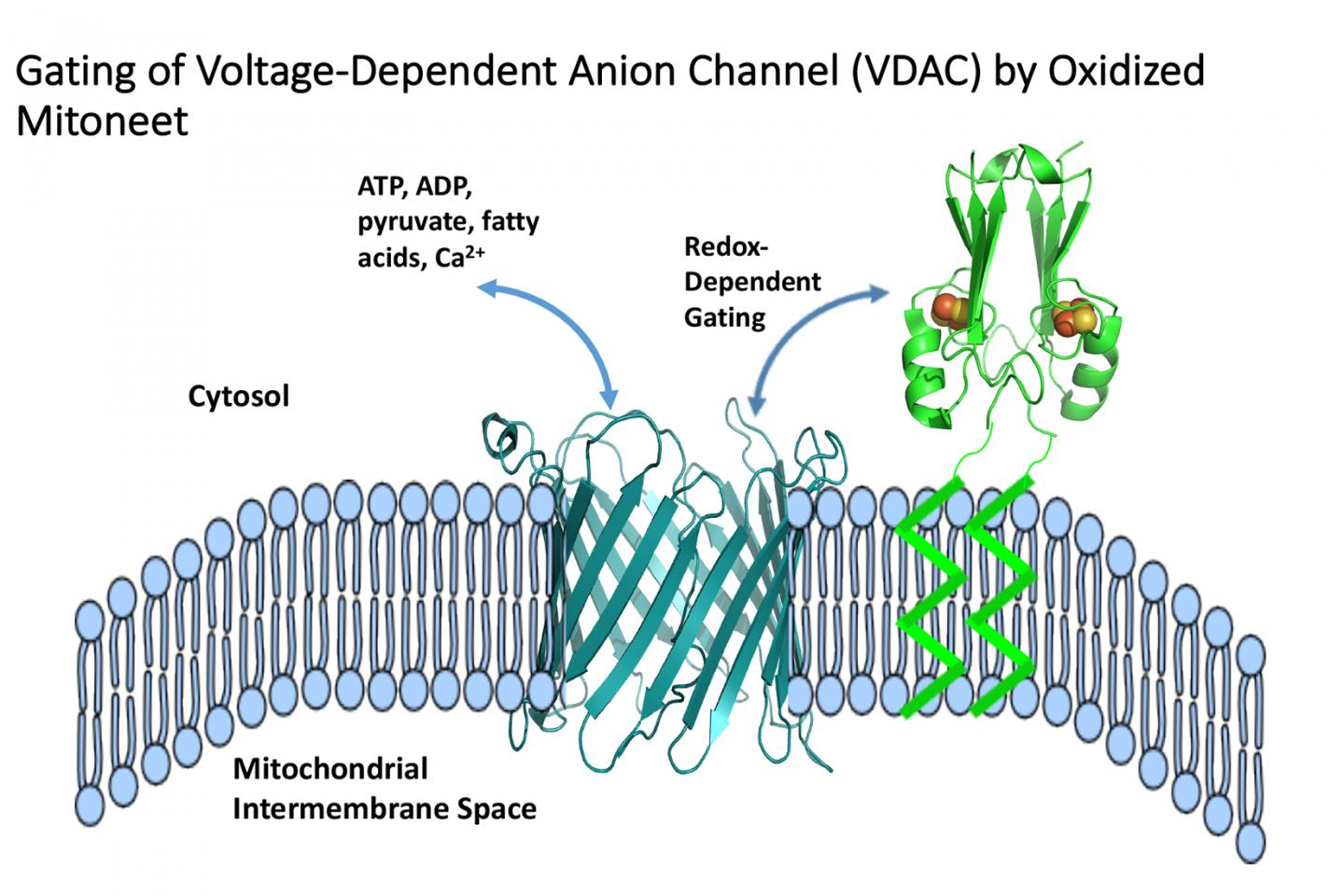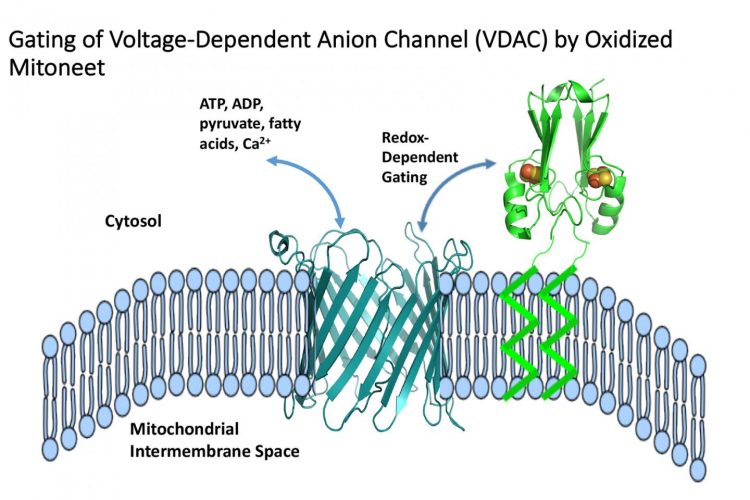Research shows how a cancer-linked protein blocks key mitochondrial gateway

Credit: CTBP/Rice University
HOUSTON — (Sept. 18, 2019) — Researchers have identified a potential new drug target in the fight against cancer.
In a study this week in the Proceedings of the National Academy of Sciences, an international team of researchers describe how a cancer-linked version of the protein mitoNEET can close the primary gateways in the outer surface of mitochondria, the “power plants” that supply cells with chemical energy. These gateways, or “voltage-dependent anion channels” (VDACs), normally open and close to allow the passage of metabolites and other small molecules between mitochondria and the rest of the cell.
“The VDAC channel transports all types of metabolites between the cytosol and the mitochondria,” said study co-author José Onuchic, a physicist and co-director of Rice University’s Center for Theoretical Biological Physics (CTBP). “Dysfunction of this channel is involved in many diseases including cancer and fatty liver disease.”
The research was performed by an international team of computational and structural biologists from CTBP, the University of California, San Diego (UCSD), the Hebrew University of Jerusalem and the University of Missouri-Columbia.
In the study, they detailed how mitoNEET regulates VDAC, and showed that the high-affinity interaction between the two proteins could be disrupted by a drug that targets VDAC.
“In its naturally occurring reduced state in healthy cells, mitoNEET has no measurable affinity for VDAC,” said Onuchic, a Cancer Prevention and Research Institute of Texas (CPRIT) Scholar in Cancer Research who led Rice’s efforts on the project. “This indicates that the mechanism of interaction is redox-dependent and that targeting of the highly important VDAC complex in diseased states can be fine-tuned.”
MitoNEET, a known player in cancer as well as diabetes, aging and Parkinson’s disease, is a member of the NEET family of proteins, which transport clusters of iron and sulfur molecules inside cells. These clusters help regulate cells by controlling reduction-oxidation, or redox processes, and metabolism.
MitoNEET naturally adheres to the outer surface of the mitochondria, and the researchers said the direct connection of mitoNEET to VDAC, one of the most abundant proteins in the mitochondrial outer membrane, is significant.
Co-author Patricia Jennings, a structural biologist at UCSD, said, “The discovery that mitoNEET directly gates VDAC, the major porin of mitochondria, as well as the accompanying structural analysis and predictions for this interaction, affords a new platform for investigations of methods to induce cancer cells to commit cell suicide, or apoptosis/ferroptosis, in a cancer-specific, regulated process.”
A defining characteristic of cancer progression is altered cellular metabolism. Study co-author Rachel Nechushtai of the Hebrew University said the work suggests it may be possible to regulate the metabolic and functional interactions of VDAC with a drug or drugs that could be useful against several kinds of cancer.
Onuchic said, “Fine-tuning a drug that specifically alters the redox-state of interaction between VDAC and mitoNEET would allow the development of new weapons to battle multiple cancers.”
Nechushtai and Jennings first detailed the molecular structure of mitoNEET in 2007, and many of the collaborators on the project have worked together for more than a decade to decipher the workings of mitoNEET and related proteins like NAF-1 and MiNT.
“The junction of iron and redox is key to the control of many different cellular processes involved in many human pathologies,” University of Missouri co-author Ron Mittler said. “Identifying a master point of regulation for these processes that is mediated by the mitoNEET-VDAC interaction is a major step forward in our understanding of these processes.”
The researchers said longstanding ties between the collaborators and joint funding from both the US and Israel played a key role in the success of the project.
###
Additional co-authors are Colin Lipper and Jason Stofleth, both of UCSD; Yang Sung Sohn of the Hebrew University; and Fang Bai and Susmita Roy, both of Rice. Onuchic is the Harry C. and Olga K. Wiess Chair of Physics and a professor of physics and astronomy at Rice.
The research was supported by the National Science Foundation (1613462, 1427654, 1614101), the U.S.-Israel Binational Science Foundation (2015831), CPRIT, the University of Missouri, the Israel Cancer Research Fund, the Keck Center for Interdisciplinary Bioscience Training of the Gulf Coast Consortia and the National Institutes of Health (R01-GM101467).
High-resolution IMAGES are available for download at:
https:/
CAPTION: José Onuchic (Photo by Jeff Fitlow/Rice University)
https:/
CAPTION: When oxidized, the protein mitoNEET (green) can close “voltage-dependent anion channels,” or VDACs (center), passageways that allow metabolites and signaling molecules to pass through the outer membrane (blue band) of the mitochondria, the “power plant” that supplies cells with chemical energy. (Image courtesy of CTBP/Rice University)
Links and resources:
The DOI of the PNAS paper is: 10.1073/pnas.1908271116
A copy of the paper is available at: http://www.
This release can be found online at news.rice.edu.
Follow Rice News and Media Relations via Twitter @RiceUNews.
Located on a 300-acre forested campus in Houston, Rice University is consistently ranked among the nation’s top 20 universities by U.S. News & World Report. Rice has highly respected schools of Architecture, Business, Continuing Studies, Engineering, Humanities, Music, Natural Sciences and Social Sciences and is home to the Baker Institute for Public Policy. With 3,962 undergraduates and 3,027 graduate students, Rice’s undergraduate student-to-faculty ratio is just under 6-to-1. Its residential college system builds close-knit communities and lifelong friendships, just one reason why Rice is ranked No. 1 for lots of race/class interaction and No. 4 for quality of life by the Princeton Review. Rice is also rated as a best value among private universities by Kiplinger’s Personal Finance.
Media Contact
Jade Boyd
[email protected]
Related Journal Article
http://dx.





